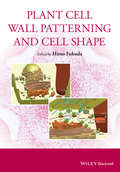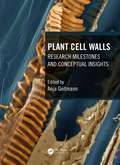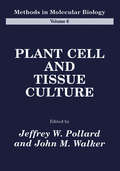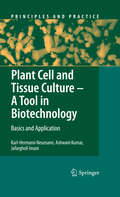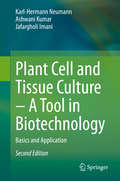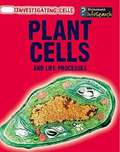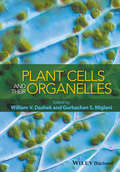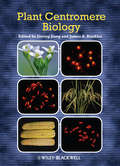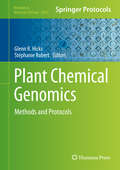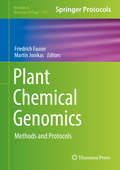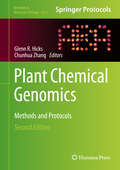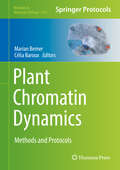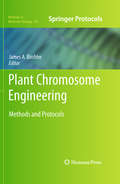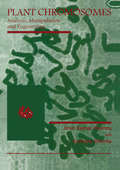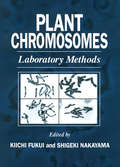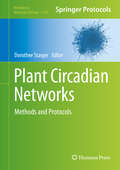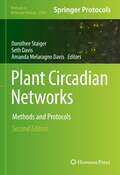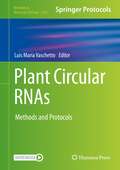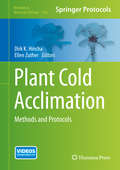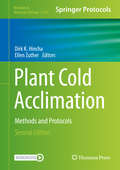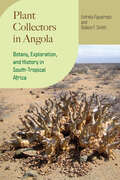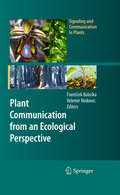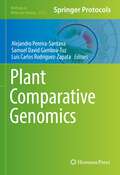- Table View
- List View
Plant Cell Wall Patterning and Cell Shape
by Hiroo FukudaCell walls are defining feature of plant life. The unique and multi-faceted role they play in plant growth and development has long been of interest to students and researchers. Plant Cell Wall Patterning and Cell Shape looks at the diverse function of cell walls in plant development, intercellular communication, and defining cell shape.Plant Cell Wall Patterning and Cell Shape is divided into three sections. The first section looks at role cell walls play in defining cell shape. The second section looks more broadly at plant development. While the third and final section looks at new insights into cell wall patterning.
Plant Cell Walls
by Keith Roberts Peter Albersheim Alan Darvill Ron Sederoff Andrew StaehelinPlant cell walls are complex, dynamic cellular structures essential for plant growth, development, physiology and adaptation. Plant Cell Walls provides an in depth and diverse view of the microanatomy, biosynthesis and molecular physiology of these cellular structures, both in the life of the plant and in their use for bioproducts and biofuels. Plant Cell Walls is a textbook for upper-level undergraduates and graduate students, as well as a professional-level reference book. Over 400 drawings, micrographs, and photographs provide visual insight into the latest research, as well as the uses of plant cell walls in everyday life, and their applications in biotechnology. Illustrated panels concisely review research methods and tools; a list of key terms is given at the end of each chapter; and extensive references organized by concept headings provide readers with guidance for entry into plant cell wall literature.Cell wall material is of considerable importance to the biofuel, food, timber, and pulp and paper industries as well as being a major focus of research in plant growth and sustainability that are of central interest in present day agriculture and biotechnology. The production and use of plants for biofuel and bioproducts in a time of need for responsible global carbon use requires a deep understanding of the fundamental biology of plants and their cell walls. Such an understanding will lead to improved plant processes and materials, and help provide a sustainable resource for meeting the future bioenergy and bioproduct needs of humankind.
Plant Cell Walls: Research Milestones and Conceptual Insights
by Anja GeitmannPlant cell walls have been relevant for human survival throughout evolution, from cell walls recognised as an essential ingredient in human and livestock nutrition, to their use in energy generation, construction, tool making, paper and clothing. This plant-generated material is at the centre of a myriad of human activities, and it represents the world's most abundant natural resource for fuel, fibre, food and fodder. Plant Cell Walls: Research Milestones and Conceptual Insights provides an overview of the key discoveries of hundreds of years of plant cell wall research. With chapter contributions from prominent scientists in the cell wall field, this book provides a comprehensive treatment of plant cell wall research, accompanied by a historical overview to illustrate how concepts have evolved, and how progress has been enabled by emerging technological advances. Plant Cell Walls: Research Milestones and Conceptual Insights elaborates on the translation of research to application in biotechnology and agriculture, and highlights its relevance for climate change mitigation and adaptation. It will be a key resource for plant cell biologists, biochemists and geneticists.
Plant Cell and Tissue Culture
by John M. Walker Jeffrey W. PollardPlant Cell and Tissue Culture continues the high standards of Humana's Methods in Molecular Biology series. Its step-by-step approach (a hallmark of the series) is applied to a wide range of basic laboratory techniques and culture conditions appropriate to plant cells. Because of the diversity of cell types, species, and culture methods, much of this volume is devoted to the culture of particular cell types and to the regeneration of these cells into whole plants. Special attention is also given to the genetic modification of plants, as well as to the economic significance of plant products. Chapters cover a wide range of topics and techniques, including:* tissue culture media and selection * cryopreservation * callus culture techniques * organ culture * embryogenesis * batch culture * large-scale culture * hormonal control * fertilization techniques * gene transfer * cell immobilization * production systems * cell product purification * DNA expression * electrofusion of plant cells * mutant selection * mutagenesis techniques * automation * transfer of nuclei * protoplast culture * media analysis * micropropagation. A detailed appendix lists the formulas for the most commonly employed plant cell media. Comprehensive, easy to follow, and a pleasure to use, Pollard and Walker's Plant Cell and Tissue Culture is an essential tool for everyone--at all levels of proficiency and experience--involved in plant culture.
Plant Cell and Tissue Culture - A Tool in Biotechnology
by Ashwani Kumar Karl-Hermann Neumann Jafargholi ImaniThis book provides a general introduction as well as a selected survey of key advances in the fascinating field of plant cell and tissue culture as a tool in biotechnology. After a detailed description of the various basic techniques employed in leading laboratories worldwide, follows an extended account of important applications in, for example, plant propagation, secondary metabolite production and gene technology. Additionally, some chapters are devoted to historical developments in this domain, metabolic aspects, nutrition, growth regulators, differentiation and the development of culture systems. The book will prove useful to both newcomers and specialists, and even "old hands" in tissue culture should find some challenging ideas to think about.
Plant Cell and Tissue Culture – A Tool in Biotechnology: Basics and Application (Principles And Practice Ser.)
by Ashwani Kumar Karl-Hermann Neumann Jafargholi ImaniThis textbook is clearly structured with fourteen richly illustrated chapters and practical examples for easy understanding and direct implementation. The methods and findings developed in the authors’ group are presented in detailed, revised chapters. Readers will find valuable updates on the molecular basis of biotechnological processes, secondary metabolite production and genetic engineering. In addition, the basic principles of important biotechnologies, as well as examples of specially designed crops that deliver improved productivity under stress conditions, are presented. This second edition sets the direction for future research on the basic aspects of plant tissue culture and its applications in the fields of secondary metabolite production and genetic engineering. It provides both general and specific information for students, teachers, academic researchers and industrial teams who are interested in new developments in plant tissue culture and its applications.
Plant Cells And Life Processes
by Barbara A. SomervillThis book explores the features of the plant cell and their life processes.
Plant Cells and their Organelles
by Gurbachan S. Miglani William V. DashekPlant Cells and Their Organelles provides a comprehensive overview of the structure and function of plant organelles. The text focuses on subcellular organelles while also providing relevant background on plant cells, tissues and organs. Coverage of the latest methods of light and electron microscopy and modern biochemical procedures for the isolation and identification of organelles help to provide a thorough and up-to-date companion text to the field of plant cell and subcellular biology. The book is designed as an advanced text for upper-level undergraduate and graduate students with student-friendly diagrams and clear explanations.
Plant Centromere Biology
by James A. Birchler Jiming JiangPlant Centromere Biology is dedicated to plant centromere research. Chapters cover the structure of centromeres from several plant species including Arabidopsis thaliana, rice, maize, wheat and beet, while other sections cover several unique characteristics associated with plant centromeres, including classical and modern neocentromeres, centromere drive and centromere misdivision. Additional chapters are dedicated to epigenetic modification and evolution of plant centromeres, and development and application of plant artificial chromosomes. Written by an international group of experts in the field, Plant Centromere Biology is a valuable handbook for all plant scientists working on plant genome research. Beyond the bench, it can also serve as a helpful reference tool or textbook for upper level college classes on cytogenetics or genome analysis.
Plant Chemical Biology
by Dominique Audenaert Paul OvervoordeDemonstrates how advances in plant chemical biology can translate to field applicationsWith contributions from a team of leading researchers and pioneers in the field, this book explains how chemical biology is used as a tool to enhance our understanding of plant biology. Readers are introduced to a variety of chemical biology studies that have provided novel insights into plant physiology and plant cellular processes. Moreover, they will discover that chemical biology not only leads to a better understanding of the underlying mechanisms of plant biology, but also the development of practical applications. For example, the authors discuss small molecules that can be used to identify targets of herbicides and develop new herbicides and plant growth regulators.The book begins with a historical perspective on plant chemical biology. Next, the authors introduce the chemical biology toolbox needed to perform successful studies, with chapters covering:Sources of small moleculesIdentification of new chemical tools by high-throughput screening (HTS)Use of chemical biology to study plant physiologyUse of chemical biology to study plant cellular processesTarget identificationTranslation of plant chemical biology from the lab to the fieldBased on the latest findings and extensively referenced, the book explores available compound collections, principles of assay design, and the use of new research tools for the development of new applications.Plant Chemical Biology is recommended for students and professionals in all facets of plant biology, including molecular biology, physiology, biochemistry, agriculture, horticulture, and agronomy. All readers will discover new approaches that can lead to the development of a healthier and more plentiful global food supply.
Plant Chemical Genomics
by Glenn R Hicks Stéphanie RobertPlant Chemical Genomics: Methods and Protocols , expert researchers in the field detail many of the techniques used for identification of bioactive compounds from a large selection of fields in plant biology including plant pathogenesis, immune responses, small RNA processing, endomembrane trafficking, lipids, plant hormone signaling and cell wall. The presentation of these and other examples as well as synthetic chemistry, computation and target identification provides a comprehensive overview of the practical aspects of chemical biology that are possible in plant systems. Small molecules and natural products that produce a phenotype in plants have been known for decades. The agrichemical industry has utilized small molecules based on known natural molecules such as auxins, cytokinins, abscissic acid and other growth regulators. In recent years, the screening and characterization of novel small molecules has enhanced our understanding of protein function, metabolic, signaling and endomembrane pathways, and their interactions in basic plant research. Written in the highly successful Methods in Molecular Biology series format, chapters include introductions to their respective topics, lists of the necessary materials and reagents, step-by-step, readily reproducible laboratory protocols, and key tips on troubleshooting and avoiding known pitfalls.
Plant Chemical Genomics: Methods And Protocols (Methods in Molecular Biology #1795)
by Friedrich Fauser Martin JonikasThis volume discusses easy-to-follow protocols for researchers in the field of plant chemical genomics. The chapters in this book look at technical workflows of high-throughput chemical compound screens in numerous plant tissues, such as seedlings, roots, and pollen. Chapters also focus on single-celled systems such as Chlamydomonas reinhardtii for chemical screens, and techniques used to modify the target of a small molecule. Written in the highly successful Methods in Molecular Biology series format, chapters include introductions to their respective topics, lists of the necessary materials and reagents, step-by-step, readily reproducible laboratory protocols, and tips on troubleshooting and avoiding known pitfalls.Thorough and cutting-edge, Plant Chemical Genomics: Methods and Protocols is a valuable resource to help researchers work with a broad variety of plants for chemical genomics approaches.
Plant Chemical Genomics: Methods and Protocols (Methods in Molecular Biology #2213)
by Glenn R. Hicks Chunhua ZhangThis second edition volume is a companion volume to the previous edition and looks at new findings on novel bioactive chemicals and cognate targets, as well as the use of synthetic small molecules and a variety of tools to understand these processes. Chapters in this book cover topics such as screening plants for novel bioactive chemicals including lipid signaling and photo receptors; small molecule screens to include peptide ligands to generate new variations; using new chemicals to affect and dissect hormone signaling; and the application of easier microscale methods to simplify target identification and validation. Written in the highly successful Methods in Molecular Biology series format, chapters include introductions to their respective topics, lists of the necessary materials and reagents, step-by-step, readily reproducible laboratory protocols, and tips on troubleshooting and avoiding known pitfalls.Cutting-edge and practical, Plant Chemical Genomics: Methods and Protocols, Second Edition is a valuable resource that provides a foundation of techniques for novice and expert researchers in the plant chemical biology community.
Plant Chromatin Dynamics
by Marian Bemer Célia BarouxThis volume provides a comprehensive collection of protocols that can be used to study plant chromatin structure and composition. Chapters divided into three sections detail the profiling of chromatin features in relation to epigenetic regulation, investigate the interaction between chromatin modifications and gene regulation, and explore the 3D spatial organization of the chromatin inside the nucleus. Written in the highly successful Methods in Molecular Biology series format, chapters include introductions to their respective topics, lists of the necessary materials and reagents, step-by-step, readily reproducible laboratory protocols, and tips on troubleshooting and avoiding known pitfalls. Authoritative and cutting-edge, Plant Chromatin Dynamics: Methods and Protocols aims to ensure successful results in the further study of this vital field.
Plant Chromosome Engineering
by James A. BirchlerWith an increasing human population and a decreasing amount of arable land, creative improvements in agriculture will be a necessity in the coming decades to maintain or improve the standard of living. In Plant Chromosome Engineering: Methods and Protocols, expert researchers present techniques for the modification of crops and other plant species in order to achieve the goal of developing the much needed novel approaches to the production of food, feed, fuel, fiber, and pharmaceuticals. This volume examines vital topics such as transformation procedures, chromosome painting, production of engineered minichromosomes, gene targeting and mutagenesis, site specific integration, gene silencing, protein expression, chromosome sorting and analysis, protocols for generating chromosomal rearrangements, enhancer trapping, and means of studying chromosomes in vivo. As a part of the highly successful Methods in Molecular BiologyTM series, the methodological chapters include brief introductions to their respective topics, lists of the necessary materials and reagents, step-by-step, readily reproducible laboratory protocols, and professional tips on troubleshooting and avoiding known pitfalls. Authoritative and cutting-edge, Plant Chromosome Engineering: Methods and Protocols highlights the spectrum of tools currently available for modifying plant genomes and chromosomes and provides the foundation for crucial future developments.
Plant Chromosomes
by Archarna SharmaThe past two decades have brought with them remarkable progress in plant chromosomal research. The chromosome structure has been clarified in great detail, enabling identification of gene sequences at the microscopic level, which has aided the analysis of biodiversity. Knowledge of chromosome structure has played a crucial role in the improvement of crop species and has far-reaching implications. The manipulation and engineering of chromosomes involves a panoply of novel methods, combining conventional and modern techniques of biotechnology. A working knowledge of such techniques is essential for today's students and researchers, and the plant system, because of totipotency, requires special treatment. This treatise covers all the latest methods involved in the study of evolution, biodiversity, chromosome manipulation and engineering.
Plant Chromosomes: Laboratory Methods
by Kiichi Fukui Shigeki NakayamaFinally - a guide to cytological techniques written specifically for the plant chromosome researcher and student. Plant Chromosomes: Laboratory Methods thoroughly covers all important approaches to the study of plant chromosomes. It reviews each specific approach and describes requisite experimental techniques. These practical descriptions cover basic, standard techniques as well as the most recent research advances and state-of-the-art technologies. Plant Chromosomes: Laboratory Methods allows you to build on the knowledge of its expert authors, who have first-hand experience with the ins and outs of each approach. Through hundreds of trouble-shooting suggestions it also helps you avoid experimental pitfalls by providing invaluable tips at critical points in the experimental process. This book gives you the information you need to improve the power of your plant chromosome research - saving you time and effort in the process. No other single volume contains so much practical information on this topic.
Plant Circadian Networks
by Dorothee StaigerPlant Circadian Networks: Methods and Protocols provides a collection of protocols to investigate clock-controlled parameters including transcript and small RNA levels, promoter activity using luciferase reporters, protein levels and posttranslational modification, protein-protein interaction, in vivo DNA-protein interaction and RNA-protein interaction, cellular redox state, Ca2+ levels, and innate immune responses. Furthermore, the use of bioinformatics resources is described to evaluate high throughput data sets and to integrate the data into an overarching picture of circadian networks in the cell. Additional chapters focus on seasonal processes like flowering time control, and techniques on trees, moss and algae Written in the highly successful Methods in Molecular Biology series format, chapters include introductions to their respective topics, lists of the necessary materials and reagents, step-by-step, readily reproducible laboratory protocols, and key tips on troubleshooting and avoiding known pitfalls. Authoritative and practical, Plant Circadian Networks: Methods and Protocols is designed not only for the chronobiology community dealing with circadian biology but also for the plant community in general.
Plant Circadian Networks: Methods and Protocols (Methods in Molecular Biology #2398)
by Seth Davis Dorothee Staiger Amanda Melaragno DavisThis second edition provides new and updated protocols to investigate clock-controlled parameters including period estimations and entrainment measurements and modelling. Chapters detail promoter activity using luciferase reporters, fluorescent-tagging of clock proteins and cellular imaging, protein level measurements, regulated RNA splicing detection, post-translational modifications, protein-protein interactions, and protein DNA/chromatin interactions. Additional chapters focus on seasonal processes like hypocotyl growth and flowering time control in annuals and trees, and techniques on soybean. Written in the format of the highly successful Methods in Molecular Biology series, each chapter includes an introduction to the topic, lists necessary materials and reagents, includes tips on troubleshooting and known pitfalls, and step-by-step, readily reproducible protocols. Authoritative and practical, Plant Circadian Networks: Methods and Protocols, Second Edition is designed not only for the chronobiology community dealing with circadian biology but also for the plant community in general. “Period estimation and rhythm detection in timeseries data using BioDare2, the free, online, community resource” is available open access under a Creative Commons Attribution 4.0 International License via link.springer.com.
Plant Circular RNAs: Methods and Protocols (Methods in Molecular Biology #2362)
by Luis María VaschettoThis volume presents readers with up-to-date protocols, bioinformatics toolkits, and reference material for understanding circRNAs in plants. The chapters in this book summarize the concepts and techniques for prediction/identification, validation, and analysis of plant circRNAs and their regulatory targets. Some of the topics covered are procedures for circRNA identification and characterization; strategies for circRNA generation; next generation sequencing (NGS) technologies and circRNAs’ research; and bioinformatics tools and pipelines for the analysis of circRNA-miRNA-mRNA regulatory networks. Written in the highly successful Methods in Molecular Biology series format, chapters include introductions to their respective topics, lists of the necessary materials and reagents, step-by-step, readily reproducible laboratory protocols, and tips on troubleshooting and avoiding known pitfalls. Authoritative and practical, Plant Circular RNAs: Methods and Protocols is an important reference for any researcher looking to explore and apply the latest developments made in this field.
Plant Cold Acclimation
by Dirk K. Hincha Ellen ZutherPlant Cold Acclimation: Methods and Protocols details many of the methods and protocols commonly used to study plant cold acclimation and freezing tolerance, breeding, genetics, physiology or molecular biology, or any combination of these specialties. Chapters focus on interdisciplinary approaches, experimental methods, and concepts from different areas of science. Written in the highly successful Methods in Molecular Biology series format, chapters include introductions to their respective topics, lists of the necessary materials and reagents, step-by-step, readily reproducible laboratory protocols, and key tips on troubleshooting and avoiding known pitfalls. Authoritative and practical, Plant Cold Acclimation: Methods and Protocols seeks to help not only new researchers starting in this field, but also those already working in a particular area of cold acclimation and freezing tolerance research who are looking to expand their range of experimental approaches.
Plant Cold Acclimation: Methods and Protocols (Methods in Molecular Biology #2156)
by Dirk K. Hincha Ellen ZutherThis detailed new edition combines a wide selection of experimental methods for plant cold acclimation, deacclimation, and cold memory, ranging from the whole plant level of ecology and breeding to molecular profiling and the detailed analysis of specific proteins, with many levels of investigated complexity in between. The collection updates methodology from the first edition while adding chapters on numerous key advances in the field. Written for the highly successful Method in Molecular Biology series, chapters include introductions to their respective topics, lists of the necessary materials and reagents, step-by-step, readily reproducible laboratory protocols, and tips on troubleshooting and avoiding known pitfalls. Authoritative and up-to-date, Plant Cold Acclimation: Methods and Protocols, Second Edition seeks to aid researchers, both new and experienced, in entering this exciting field of research or broadening the scope of their investigations.
Plant Collectors in Angola: Botany, Exploration, and History in South-Tropical Africa (Regnum Vegetabile)
by Estrela Figueiredo Gideon F. SmithAn authoritative treatise on the history of botanical studies and exploration in Angola. For any region, cataloging, interpreting, and understanding the history of botanical exploration and plant collecting, and the preserved specimens that were amassed as a result, are critically important for research and conservation. In this book, published in cooperation with the International Association for Plant Taxonomy, Estrela Figueiredo and Gideon F. Smith, both botanists with expertise in the taxonomy of African plants, provide the first comprehensive, contextualized account of plant collecting in Angola, a large country in south-tropical Africa. An essential book for anyone concerned with the biodiversity and history of Africa, this authoritative work offers insights into the lives, times, and endeavors of 358 collectors. In addition, the authors present analyses of the records that accompanied the collectors’ preserved specimens. Illustrated in color throughout, the book fills a large gap in the current knowledge of the botanical and exploration history of Africa.
Plant Communication from an Ecological Perspective
by František Baluška Velemir NinkovicThis book shows the complexity of plant signaling and behavior in an ecological context and is intended to increase our understanding of it. It reflects the multifaceted interactions between plants and other organisms that affect their growth and development. In addition it puts emphasis on the effects of plant signaling and behavior on other trophic levels. This field of research is growing and developing rapidly, and new findings are regularly reported. Thus, this book provides a broader view of the field and represents a valuable reference work on the current state of research.
Plant Comparative Genomics (Methods in Molecular Biology #2512)
by Alejandro Pereira-Santana Samuel David Gamboa-Tuz Luis Carlos Rodríguez-ZapataThis detailed book presents recent methodologies for the task of inspecting the genomic world of plants, extracting valuable information, and presenting it in a readable way. With a focus on bioinformatics tools, the volume explores phylogenetics and evolution, Omics analysis, as well as experimental procedures for trait characterization. Written for the highly successful Methods in Molecular Biology series, chapters include the kind of vital expert implementation advice that will lead to successful results. Authoritative and practical, Plant Comparative Genomics serves as an ideal resource for researchers looking to implement comparative tools in order to explore their genomic data for their daily scientific work.
